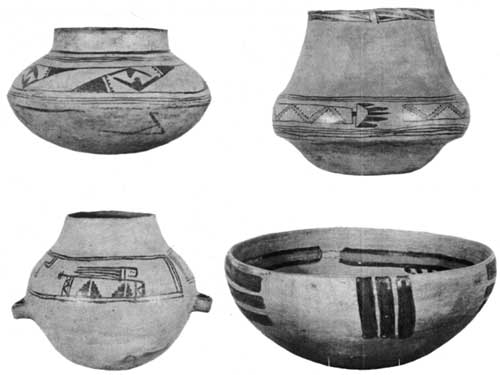|
BANDELIER National Monument |
 |

Typical prehistoric pottery vessels made in the Bandelier
vicinity.
(Photo courtesy Museum of New Mexico.)
Origins of the People
THE BASKETMAKERS AND THE DEVELOPMENTAL PUEBLO PERIOD. As a result of such concerted study and deduction, there exists today a fairly solid understanding of the general course of human events in the Southwest for the past 2,000 years. Many details are still missing, and some will always be, but the general outline of Indian life and customs is established back to the early centuries of the Christian era; beyond that, the picture becomes hazy. Those earlier years were seemingly times of a seminomadic, hunting-gathering existence for the early Southwesterners; only from about 3,000 years ago is there clear evidence of the advent of intensive farming and a settled life.
As soon as agriculture became their primary sustenance, the people began to live more or less permanently in one place. From certain early cave-shelters are derived the clues which begin to formulate the story of the days before history. Human burials have been found in the earth floors of shallow caves scattered through the San Juan river drainage; and in these same caves are found storage chambers prepared to protect the foodstuffs, principally corn. Their outstanding handicraft was basketry, as far as remaining evidence shows. Because of the great numbers of skillfully worked baskets found in their homesites, archeologists have named these people Basketmakers. It is now quite certain that the Indians who came much later to live in the Bandelier vicinity can claim as ancestors the Basketmaker people of the area to the west.
The life of these ancestral farmers was a primitive one, even by the standards which prevailed in Frijoles Canyon 1,000 years later. For one thing, no permanent dwellings appear to have been constructed until late in Basketmaker times, and even then dwellings were of crude pithouse type—an excavation some 3 feet into the ground, walled up and roofed with logs, brush, and earth. Further, the bow and arrow was not used by these people until perhaps A. D. 600; the early weapon of hunting and warfare was the spear and spear-thrower (atlatl). For the greater part of Basketmaker times, pottery was unknown; only after A. D. 400 was true fired pottery introduced in the northern Southwest.
The production of decorated pottery late in Basketmaker times began a development which has had the greatest archeological significance. The long-enduring fragments of painted pottery found in subsequent housesites have been a principal tool by which students have pieced together the relative chronology of ruins and the migrations of the pottery-makers.
With successive introduction of pottery, the bow and arrow, and other new traits in the approximate period A. D. 450 to 750, the character of Basketmaker life became so modified that a new name— the Pueblos—was applied to the subsequent peoples. Presently they began to move from the Basketmaker pithouse into masonry chambers above ground, perhaps with several rooms connected, the old pithouse surviving in use as the ceremonial kiva. Cotton came under cultivation and was woven into garments. Hoes and axes of stone with serviceable handles came into use. Turkeys and dogs were by this time commonly domesticated, the former being valued primarily for feathers which served to make warm robes and ceremonial garb.

|

|
|
Last Modified: Sat, Jan 6 2001 10:00:00 am PDT |


